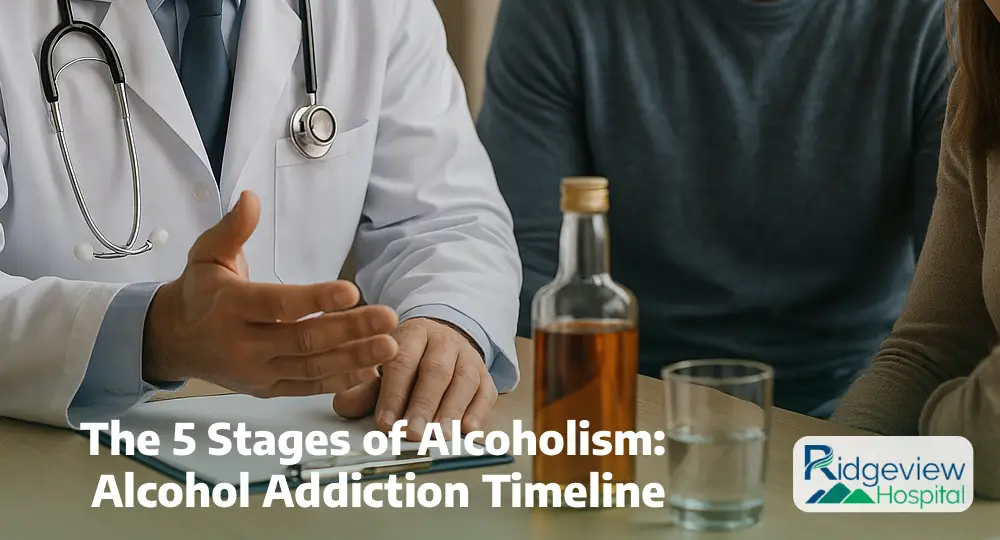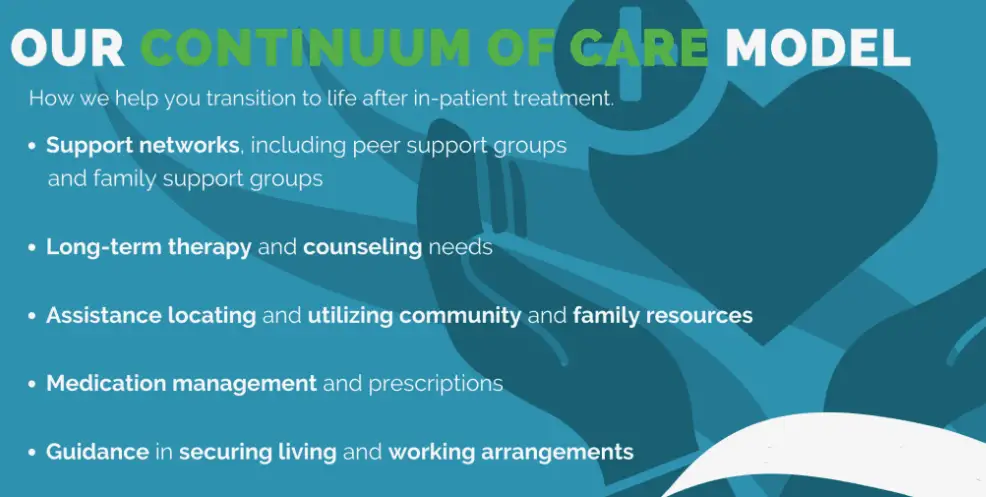Since drinking is socially accepted in many cultures, it can be challenging to spot the difference between a person who likes to have a few drinks to relax and someone with a real problem. Unfortunately, alcohol use disorder is a serious issue that affects people from all walks of life. Thankfully, alcohol treatment and rehabilitation options in Middle Point, Ohio, can help them achieve long-term recovery.
Frequently Asked Questions About Alcohol Use Disorder

What Is Alcohol Use Disorder?
Alcohol use disorder (AUD) or alcoholism is characterized by an impaired ability to control or stop alcohol use despite adverse health, social, or occupational consequences. Since AUD is an actual disease that causes changes to the brain and neurochemistry, someone addicted to alcohol may find it challenging to control their actions.
People used to refer to someone with AUD as an alcoholic. However, health professionals see this label as both unhelpful and damaging. Today, a person who has a desire or physical need to drink excessive amounts of alcohol is referred to as someone who has an AUD.
What Are the Symptoms of AUD?
The symptoms of AUD are a combination of craving, physical dependence, increasing tolerance for alcohol, and loss of control. It’s important to note that alcohol addiction can manifest itself in various ways. For this reason, the alcohol someone consumes, how often they drink, and the severity of the condition varies from one person to another.
While some people binge drink then stay sober for a while, others drink heavily all day. Regardless of how alcohol addiction looks, someone with AUD is often not the first person to realize that they have AUD.
- They Drink More Than They Mean To
The individual ends up drinking more or longer than they originally intended. In other words, they’re unable to curb or restrain their drinking.
- They Develop Alcohol Tolerance
The chronic drinker usually develops tolerance to some of alcohol’s effects. As their tolerance increases, they’ll notice that their usual number of drinks has significantly less impact than before. Moreover, they’ll require more alcohol to appear intoxicated or get the desired effect.
However, their tolerance may drop if their central nervous system is impaired or their liver is too damaged to metabolize the alcohol they consume.
- They Spend More Time Drinking
Besides spending as much time as possible drinking alcohol, the person also spends a considerable chunk of their time recovering from the side effects of being drunk and ensuring they have alcohol available.
- They Experience Withdrawal Symptoms
When the person cuts down or abstains from alcohol, they experience withdrawal symptoms such as anxiety, tremors, nausea, trouble sleeping, restlessness, heart palpitations, excessive sweating, or seizure. In some cases, they may even sense things that aren’t there. Most sufferers try to avoid these unpleasant withdrawal symptoms by drinking more.
- They Try To Cut Down or Stop Drinking but Can’t
Although the individual may have a persistent desire to cut down or stop drinking, they’re unsuccessful.
- They Withdraw from Activities That Used To Be Important to Them
The person loses their interest in recreational, social, or occupational activities they used to participate in. Instead of spending their time on activities that gave them pleasure, they drink.
- They Have a Driving Need for Alcohol Intake
The individual experiences an intense craving for a drink to the point that they couldn’t think of anything else.
- They Continue to Drink Even if It Negatively Impacts Their Life
The person keeps on drinking even if they’re aware that this behavior is causing problems or interferes with their health, relationships, school, work, finances, or the law. Moreover, they don’t stop drinking even after they’ve gotten themselves into situations while or after drinking that increased their chances of getting hurt.
How Is a Person Diagnosed with AUD?

The American Psychiatric Association (APS) published the Diagnostic and Statistical Manual of Mental Disorders (DSM), outlining healthcare professionals’ criteria to assess whether an individual has AUD. These experts use the same standards to determine its severity if AUD is present, whether mild, moderate, or severe. The presence of at least two of the previously mentioned symptoms during the past 12 months indicates AUD.
Moreover, a person is diagnosed with mild AUD if they exhibit two to three symptoms. If the individual has four to five symptoms, they’re diagnosed with moderate AUD. They’re diagnosed with severe AUD if they show six or more symptoms.
What Are the Risk Factors of AUD?
Healthcare experts link excessive drinking to several risk factors such as the following:
- Genetics and Family History of Alcohol Issues
A person’s genetic makeup influences how their body processes and responds to alcohol. Additionally, AUD often runs in families. Someone who has parents, siblings, or children with AUD is likely to have the disorder.
- Early Alcohol Use
People who began drinking before age 15 are five times more likely to have issues with alcohol later in life than those who waited until age 21 or later to have their first alcoholic drink.
- Mental Health Problems and a History of Trauma
Psychiatric conditions such as post-traumatic stress disorder (PTSD), depression, and attention deficit hyperactivity disorder (ADHD) are often associated with an increased risk of AUD. Additionally, someone who has a history of emotional trauma is susceptible to AUD.
What Are the Complications of AUD?
Heavy and regular drinking may lead to complications over time. These include the following:
- Dementia
Excessive alcohol consumption can cause frequent head injuries that damage the brain and lead to dementia. Dementia is a term for loss of language, memory, problem-solving, and other cognitive abilities that are severe enough to interfere with an individual’s daily life.
- Wernicke-Korsakoff Syndrome
Chronic alcohol misuse is closely linked to Wernicke-Korsakoffe Syndrome, another brain condition characterized by the inability to learn new information and remember recent events.
- Heart Conditions
Excessive drinking leads to high blood pressure, stroke, irregular heartbeat, and cardiomyopathy or heart muscle disease.
- Liver Issues
Alcohol can cause fatty liver or steatosis, alcoholic hepatitis, thickening of liver tissue or fibrosis, scarring and permanent damage to the liver or cirrhosis, and alcoholic hepatitis.
- Gastrointestinal Problems
Alcoholism leads to mucosal damage in the GI tract and alcohol-induced digestive disorders that cause nausea, vomiting, appetite loss, flatulence, fullness, and abdominal pain.
- Cancers
Alcohol increases a person’s risk for cancers, including cancers of the mouth, throat, esophagus, liver, and breast.
- Pulmonary Infections
People with AUD are at risk for pulmonary infections such as tuberculosis (TB), pneumonia, respiratory syncytial virus (RSV) infection, and acute respiratory distress syndrome (ARDS).
FAQ
1. What is Alcohol Use Disorder (AUD)?
Alcohol Use Disorder (AUD) is a medical condition characterized by an inability to stop or control alcohol use despite adverse social, occupational, or health consequences. It encompasses a range of drinking problems from mild to severe, and includes what is commonly known as alcoholism.
2. What are the symptoms of Alcohol Use Disorder?
Symptoms of Alcohol Use Disorder include a strong craving for alcohol, loss of control over drinking, withdrawal symptoms when not drinking, and continuing to drink despite knowing the harms it causes. It may also involve drinking more or for longer than intended, and neglecting responsibilities due to drinking.
3. How is Alcohol Use Disorder diagnosed?
Alcohol Use Disorder is diagnosed based on criteria outlined in the Diagnostic and Statistical Manual of Mental Disorders (DSM-5). A healthcare professional will evaluate a person’s drinking habits, the impact of alcohol on their life, and any physical or psychological symptoms to make a diagnosis.
4. What treatment options are available for Alcohol Use Disorder?
Treatment for Alcohol Use Disorder may include behavioral therapies, counseling, medication, and support groups. Approaches like cognitive-behavioral therapy (CBT), motivational enhancement therapy (MET), and 12-step programs are common. In severe cases, inpatient rehabilitation may be necessary.
5. Can Alcohol Use Disorder be prevented?
Preventing Alcohol Use Disorder involves understanding risk factors and promoting healthy behaviors. Strategies include educating individuals about the risks of excessive drinking, promoting alcohol-free activities, and early intervention when signs of problematic drinking appear. Support from family and community can also play a crucial role.
Looking for an Alcohol Treatment and Rehabilitation Center in Middle Point, Ohio?
More than anything, patients need to know that they will receive the best possible care. It’s important to remember that the care you need today may be different from the care you need tomorrow. There are many types of therapy available at Ridgeview Behavioral Hospital, so reach out if you need assistance in the Middle Point, Ohio area.
Call (419) 949-8590 to speak with one of our treatment specialists and learn more about our programs. Take our 😍 Mental Health Assessment or our 🧐 Addiction Test.





















